Aug 28, 2008
Is Earth Still Recovering from the “Little Ice Age?”
By Syun-Ichi Akasofu, International Arctic Research Center
An almost linear global temperature increase of about 0.5C/100 years (~1F/100 years) seems to have started at least one hundred years before 1946, when manmade CO2 in the atmosphere began to increase rapidly. This value of 0.5C/100 years may be compared with what the International Panel on Climate Change (IPCC) scientists consider to be the manmade greenhouse effect of 0.6C/100 years. This 100-year long linear warming trend is likely to be a natural change.
One possible cause of the linear increase may be Earth’s continuing recovery from the Little Ice Age (1400-1800). This trend (0.5C/100 years) should be subtracted from the temperature data during the last 100 years when estimating the manmade contribution to the present global warming trend. As a result, there is a possibility that only a small fraction of the present warming trend is attributable to the greenhouse effect resulting from human activities. Note that both glaciers and sea ice in the Arctic Ocean that had developed during the Little Ice Age began to recede after 1800 and are still receding; their recession is not a recent phenomenon. One lesson here is that it is not possible to study climate change without long-term data. In fact, one way to learn about natural changes is to examine climate change before the greenhouse effect of CO2 became significant in about 1946.
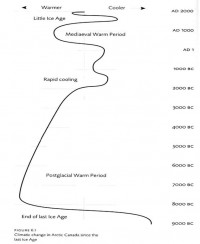
Climate change in arctic Canada after the last major ice age (McGhee, 1941). Larger image here.
The present rapid retreat of sea ice in the Arctic Ocean, particularly in 2007, is caused by the inflow of the warm North Atlantic water into the Arctic Ocean and the effects of winds. Figure below shows the results of the ocean monitoring effort by an international group, led by the International Arctic Research Center.
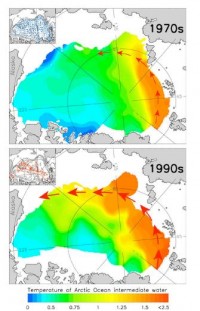
Inflow of warm North Atlantic water into the Arctic Ocean (Polyakov, 2006). Larger image here.
This warm water is melting sea ice from the bottom. The resulting thin ice tends to break up easily by stormy water and is easily forced to flow by winds; nothing can move sea ice (which covers an area of the United States) in the Arctic Ocean, if it is a single plate. This was exactly what happened in the fall of 2007, resulting in a large recession of sea ice toward the Canadian side (some expected further shrinking in 2008, but that is unlikely). It was shown by Polyakov (2006) that this inflow is a quasi-periodic phenomenon.
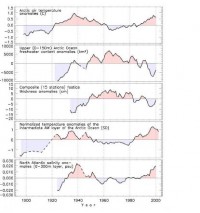
Air temperature and various conditions of the Arctic Ocean between 1895 and 2000 (Polyakov et al., 2008). Larger image here.
The Earth as a whole experienced a relatively cold period, the Little Ice Age (LIA), between 1400 and 1800. The Earth is still recovering from the LIA. There is nothing unusual or abnormal about the present global warming trend and temperature. There were a number of periods when the temperature was higher than the present.The predicted temperature in 2100 by the IPCC is not reliable, because the present GCMs are adjusted or “tuned” to result in the 0.6C/100 years increase by hypothesizing the CO2 effect. Read this very detailed note here.
Aug 26, 2008
Snowpack Study Shows No Long-Term Climate Change Signal
By Phyllis Fletcher, KUOW News
A new study from the University of Washington indicates that climate change may not be the reason snowpack is shrinking in the Cascade Mountains. The finding is in contrast with science and policy that have dominated the discussion of snowpack, flood, and water resources.
The new study is authored by several atmospheric scientists, including KUOW regular Cliff Mass. Mass says the amount of snowpack has not changed appreciably in the last 30 years. He and his colleagues argue that much of the change in the last century could be attributed to a weather pattern that has nothing to do with global warming caused by human activity.
It’s a conundrum for policymakers. And for everyone else who’s not a scientist. Alan Hamlet is a research hydrologist at the University of Washington. He says lawmakers want to hear from scientists before they decide what to do. Hamlet said: “And this whole debate that has been going on about the snowpack was really spawned by a number of policy people citing numbers like a 50% downward trend in snowpack (based on Mote 2005 BAMS) Which some people felt was overstated, and really they were worried about the policy kind of going too far in the other direction.”
Hamlet’s opinion is that the most recent paper may overstate the case against global warming as a cause for snowpack shrinking in the cascades. He says this kind of disagreement is hard for people who want to regulate water supply and carbon emissions. But it’s not so hard for people like him and Cliff Mass. According to Hamlet, “These kinds of debates are normal in the scientific community. And I think there’s a lot of consensus here too. So we’re wrangling back and forth and I think over time a clearer picture will emerge.” Ten years ago it was easy to find scientific reports with confident claims that linked a shrinking snowpack in the northwest to global warming. You could even find policy recommendations in some of them. Today the discussion is more nuanced, and scientists try to keep policy out of their papers. The latest study from U.W. scientists awaits peer review.
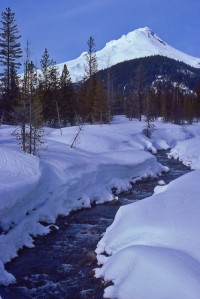
See recent story by George Taylor here and earlier story on Mote’s paper here. It will be interesting to see if the AMS which quickly accepted Mote’s paper for publication because it fit their AGW advocacy position will accept the Mass etal submission to the Journal of Climate. Dr. Mass is highly regarded in the AMS which will help the cause.
Aug 25, 2008
One Hot Topic
By John Takeuchi, Meteorologist Interview in the Vacaville, CA Reporter
Q. Is the atmosphere warming?
A. In some places, yes; in other places, no.
Q. Is warming unusual?
A. No, the atmosphere has periodic warming and cooling cycles.
Q. Does CO2 cause global temperatures to rise?
A. Carbon dioxide (CO2) is a minor component of the atmosphere - historically between 0.022 percent and 0.038 percent - and its contribution to heat retention is likely minor when compared to that of water vapor, which is the dominant “greenhouse gas.” Global warming proponents claim that human activity is increasing CO2 in the atmosphere - that’s true - and that the increased CO2 is causing air temperature to rise. Studies, however, point elsewhere. When long-term plots of global temperature and CO2 content are overlaid, CO2 lags temperature. There must be another culprit. Oceans are the main repository for CO2. They release CO2 as their temperature rises - just like your beer. This strongly suggests that warming oceans - heated by the sun - are a major contributor to CO2 in the atmosphere.
Q. Why all the fuss about global warming?
A. Note that environmentalists and politicians are leading the charge. Environmentalists are trying to stop growth by predicting catastrophe as the atmosphere warms - people starving; species dying as habitat disappears; cities inundated by rising sea levels - without any evidence that these outcomes are even feasible. Lately, politicians have come to see global warming as a way to raise revenue by rationing CO2 production with schemes such as the “cap and trade” legislation now in Congress. The taxes assessed for producing CO2 could be huge. But global warming as proclaimed by Al Gore and Co., is a hoax. Much is made of the “consensus” in the United Nations committee dealing with global warming. It should be noted that very few of its members are meteorologists. It should also be remembered that science is based on facts, not consensus. The facts do not point to the dire consequences promoted so loudly by Mr. Gore and the media. The global warming story is full of half-truths, outright falsehoods and speculation. That Mr. Gore received a Nobel Prize and an Academy Award shows the politics of those organizations, not any scientific acumen.
Q. So what?
A. Ignored by global warming promoters is the human cost of their remedies. Reducing CO2 to below 1980 levels means shutting down economies dependent on hydrocarbon-based energy: natural gas, petroleum, coal. Visualize the dreary world in a Charles Dickens’ tale. That’s what America would look like. Solar, wind and hydro cannot fill the gap - yet. Until we improve such technologies, we must go after the oil offshore and in Alaska. And we must go nuclear. Starting now. Read more of this interview here
Aug 24, 2008
Who Rules the Climate?
By Dr. Arnd Bernaerts, Oceanclimate
Water rules nature!: Not nature rules climate, but water rules the nature on this earth. Water is the essence of anything that makes the earth special, as a brief comparison with the moon quickly shows. Earth’s water volume is to 97% contained by the oceans, which have an average temperature of just ca. 4 degrees. Only their huge storage of heat and water supply to the atmosphere make climate, although variable, and life on earth possible. Climate would not exist, and could not work without water.
Even after having existed for many decades, the science of weather and climate did not attach the importance to the oceans which they deserved. In 1939 at the latest, it should have become apparent to experts that climate is a function of water. Leonardo da Vinci (1452 - 1519) put it succinctly long ago: “Water is the driver of nature.” Since the oceans exceed the total amount of atmospheric moisture by a factor of 1000, there is ample justification for defining climate as the “continuation of the seas by other means,” because they feed gigantic quantities of heat and water into the atmosphere (see above). If climate had been understood in this sense at the time, it would have been possible to mitigate the rising political turbulences in 1939 at least to some degree by warning about the climate changes which would occur. But the science of meteorology did not understand much at that time and said nothing.
For more than 20 years now, scientists have believed they are called upon to predict apocalyptic scenarios of climate change and to demand costly programmes and taxes from politicians. They do so without any consideration of events which their fathers and grandfathers experienced themselves. Those generations marched off to a world war in 1939, and only four months later there was a collapse of the climate. The temperatures in Northern Europe fell to a level which was extreme even for the small ice age. Such low temperatures had not been experienced in more than 100 years. The temperatures were 5 - 10 degrees below the average of many years. Although this was not even 69 years ago, the extreme winter of 1939/40 remains un-investigated.
The two following winters, 1940/41 and 1941/42, set a large number of records for cold in Northern Europe as well as marking the start of a noticeable cooling of the northern hemisphere lasting more than three decades. In 1948, the German meteorologist M. Rodewald described it in this way: “(It is shown) a “secular heat wave” made itself felt over most of the Earth. We noticed this especially in the increasing mildness of the winters which, while beginning in the previous century, became more and more striking between 1900 and 1939. So it is all the more surprising that there was a series of three severe winters in succession in 1939/40, 1940/41 and 1941/42, appearing to indicate a sudden reversal of the previous development rather than a slow deceleration, contrary to the sustainment tendency of circulation and temperature deviation.” Anyone who claims to understand climate change must also be able to explain these events. Anyone who can explain these events will recognise that the oceans play the key role in any and all questions of the climate.
Climate is the continuation of the oceans by other means: The overriding effect of the oceans rectify this definition for CLIMATE. It would bring the focus to the backbone of the climate system. At least the general public would understand for what the term CLIMATE stand for. Once adopted it would presumably lead quickly to the understanding of the two major climatic shifts during the last Century, namely the early arctic warming that started in winter 1918/19, and the global cooling that started in winter 1939/40 lasting for three decades. Intro above from Ocean Climate. In the following paper on that site, the sudden cooling at the end of the warmest decade of the 20th century is described.
Europe suddenly experienced its coldest winter in more than 100 years. Since the 19th century, winters had become successively milder. “The present century has been marked by such a widespread tendency towards mild winters that the ‘old-fashioned winters’, (sound familiar?) of which one had heard so much, seemed to have gone for ever. The sudden arrival at the end of 1939 of what was to be the beginning of a series of cold winters was therefore all the more surprising,” reported the British scientist A. J. Drummond in the QJoR Met. Society as early as 1943. But neither he nor climate researchers in general went searching for the cause. This article explores the possible reasons.
See also this story in which Arnd shows how the oceans are shown to play a role in the arctic cyclical warming and cooling.
Aug 24, 2008
No Trend in Drought or Floods
Climate Skeptic
It is often said by warming alarmists that a) global warming will increase both extremes of droughts and floods and b) that we already see these conditions accelerating (ie with California droughts and this year’s midwestern floods). The recent NOAA/NASA draft CCSP climate change report I commented on last week said
“Temperature and precipitation have increased over recent decades, along with some extreme weather events such as heat waves and heavy downpours.
Widespread increases in heavy precipitation events have occurred, even in places where total amounts have decreased. These changes are associated with the fact that warmer air holds more water vapor evaporating from the world’s oceans and land surface. Increases in drought are not uniform, and some regions have seen increases in the occurrences of both droughts and floods”
The Antiplanner, in an article on firefighting, shares this data at the National Climate Data Center that I had never seen before. It is the monthly estimate of the percent of US land area subject to extremes of wet or dry weather. First, the dry weather:
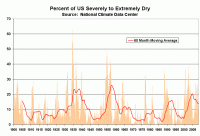
See larger image here
And then the wet weather:
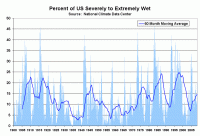
See larger image here
There is no trend here, and certainly no acceleration of a trend, merely what is obviously a cyclical phenomenon.
I am constantly amazed at the ability of alarmists to dedice the second derivitive of natural phenomenon (eg an acceleration in a rate of change) from single data points (e.g. 2008 flooding in the Midwest). Read more here.
|








